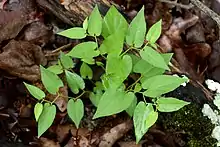Aristolochia serpentaria
Aristolochia serpentaria is a species of perennial flowering plant in the Aristolochiaceae (birthwort) family. The species is commonly known as Virginia snakeroot and is native to eastern North America, from Connecticut to southern Michigan and south to Texas and Florida.[1][2]
| Aristolochia serpentaria | |
|---|---|
 | |
| Scientific classification | |
| Kingdom: | Plantae |
| Clade: | Tracheophytes |
| Clade: | Angiosperms |
| Clade: | Magnoliids |
| Order: | Piperales |
| Family: | Aristolochiaceae |
| Genus: | Aristolochia |
| Species: | A. serpentaria |
| Binomial name | |
| Aristolochia serpentaria | |
| Synonyms | |
| |
Description and Ecology
They have pipe-shaped flowers and heart-shaped leaves. It is a larval host to the pipevine swallowtail and the polydamas swallowtail.[3]
Protection
Virginia snakeroot is considered an endangered species in New York, where no reports of the species were made for the century between 1895 and 1994, when it was rediscovered in the Hudson Highlands. Since then, other scattered populations have been observed in the state.[4]
The plant is also rare in Connecticut, where it is on that state's list of species of special concern.[5][6] In Michigan, its status is "Threatened."[2]
References
- Aristolochia serpentaria USDA Plants Profile (2011-11-28)
- Aristolochia serpentaria Archived August 17, 2011, at the Wayback Machine Michigan Natural Features Inventory (2011-11-28)
- The Xerces Society (2016), Gardening for Butterflies: How You Can Attract and Protect Beautiful, Beneficial Insects, Timber Press.
- Virginia Snakeroot New York Natural Heritage Program (2011-11-28)
- Virginia Snakeroot Connecticut Botanical Society - Wildflowers (2011-11-28)
- "Connecticut's Endangered, Threatened and Special Concern Species 2015". State of Connecticut Department of Energy and Environmental Protection Bureau of Natural Resources. Retrieved 1 January 2018. (Note: This list is newer and updated from the one used by plants.usda.gov)
| Wikimedia Commons has media related to Aristolochia serpentaria. |